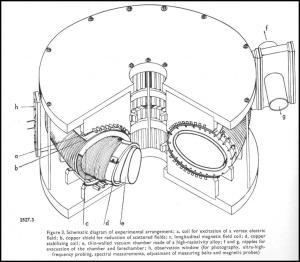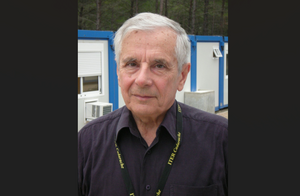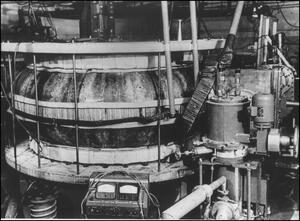Which was the first "tokamak"—or was it "tokomag"?
Among the 2,100 papers submitted by the participants to the Second Atoms for Peace conference, held in Geneva in October 1958, was an article about the "Stability and Heating of Plasmas in Toroidal Chambers." The paper presented the results Soviet fusion scientists had achieved in an "experimental arrangement"—a small fusion machine which is generally considered to be the first tokamak in history. Nowhere in the article did the word "tokamak" appear, nor did the "arrangement," now referred to as T-1, have a name of its own.
"Experimenting with toroidal configurations started in the mid-1950s," remembers Vladimir Mukhovatov, now a Senior Scientific Officer with the ITER Organization, then a 23-year-old researcher freshly out of Moscow State University. "Our 'Sector-44' within the Laboratory of Measuring Apparatus of Academy of Science—the future Kurchatov Institute—was building machines at a very fast pace. When I arrived in 1956 for my graduation thesis, there was a small toroidal device called TMP, originally equipped with a porcelain chamber which was soon improved by adding metal spirals within the chamber. Later two small devices with copper walls and insulating gaps were built."
By "late 1957," according to Mukhovatov's recollection, these devices were succeeded by T-1 which was somewhat larger and marks the "symbolic beginning" of the tokamak adventure. T-1 was the first device to have a stainless steel liner inside a copper vacuum chamber.
Finding a name for this new toroidal concept was to take some time and quite a bit of discussion. "Igor Golovin, then vice-director of the laboratory, came up with an acronym: 'Tokamak' for Toroidalnaya Kamera i Magnitnaya Katushka (Toroidal Chamber and Magnetic Coil). A combination of "Tok" for electric current and "Mag" for magnetic field, with a connective vowel 'o', which gave "tokomag" or "tokomak" after replacing "G" with "K" for harmony, was also circulated..."
Whether it was 'Tokomag' or 'Tokamak' ... Lev Artsimovitch, head of Department of Plasma Research, was initially sceptical about the concept. Vladimir Mukhovatov remembers the man "liked to use strong, spectacular, sentences." "When engaging in polemics, he would say that 'achieving fusion with a tokamak was the same as trying to create a cigarette out of cigarette smoke.' It is only after experiments on T-2, TM-2 and especially T-3 that he became a strong proponent of tokamaks. And in a way, this led to ITER."




